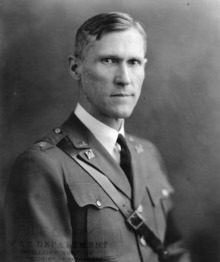James W. Bagley
| James W. Bagley | |
|---|---|

Bagley, U.S. Army Corps of Engineers topographic engineer, and commander of the 29th Engineer Regiment
|
|
| Born |
James Warren Bagley October 31, 1881 Fayetteville, Tennessee |
| Died | February 19, 1947 (aged 65) Chattanooga, Tennessee |
| Nationality | American |
| Occupation | topographic engineer |
| Known for | topographic engineering, aerial photography, invention of cameras |
Major James Warren Bagley (October 31, 1881 – February 19, 1947) was an American aerial photographer, topographic engineer and inventor.
Bagley was born in Fayetteville, Tennessee. He took an early interest in mathematics and engineering, and attended Washington and Lee University, where he graduated in 1903. Edwin Raiz said in his obituary of Major Bagley, "James Warren Bagley was born on October 31, 1881, at Fayetteville. Tennessee, into a distinguished southern family. Even as a student he showed a marked interest in mathematics and engineering. He pursued his studies at Washington and Lee University, where he received a Phi Beta Kappa key. He was graduated in 1903."
Bagley was a popular athlete at his university, and during a football game between Washington and Lee and the Virginia Military Institute, he was badly injured while playing guard, and was carried unconscious from the field. There was a resulting rampage by the students that continued off the field, and into the town of Lexington and on to the campus of VMI. As a result, all games between these two schools were banned for the next fifty years.
Bagley was an employee of the US Geological Survey from 1905 to 1917, when he was called into service for World War I. During his time with the USGS, he helped develop a panoramic camera used to document the topography and geology Alaska.
In 1911, James Bagley was instructed to return to Washington from his work in Alaska, and to come through Ottawa. He was instructed "to investigate the method of photo-topographic surveys in use by the Canadian government, with a view of obtaining infomratino which will be useful in introducing these methods for some of the Alaskan surveys." That winter, Baglet, F. H. Moffit and J. B. Mertie, two geologists, developed their ideas for the construction of a tri-lens camera and transformer in 1916.
"The USGS surveyor most closely associated with the development and use of the panoramic camera system in Alaska was Maj. James W. Bagley. In 1917, Bagley wrote USGS Bulletin 657, The Use of the Panoramic Camera in Topographic Surveying. In retrospect, the history, justification, technical information, documentary evidence, and mathematical formulas found in this bulletin make it one of the most important publications ever produced on the scientific uses of the panorama. While most swing-lens panoramic cameras were used for scenic or group shots, Bagley found a way to use it for precise topographic measurements that would be used by geographers during this crucial period in Alaska's history."
...
Wikipedia
